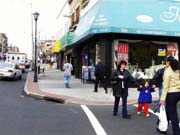For the last year or so, the city’s official website has proudly announced: “The City of Jersey City – New Jersey’s Largest City By The Year 2000!”
The results are in, and it might be time to modify that statement.
When the U.S. Department of Census released its figures two weeks ago, Newark retained its hold as the state’s most populous city, at 273,000, down about 2,000. While Jersey City’s total spiked from 228,500 to 240,000, it still clocks in as number two. So unless 34,000 or so Jersey City residents happened to be out of town or hiding in the basement when the census-takers came by, the city will have to bide its time until 2010.
That was one of only a number of interesting findings in this year’s official head count. Information gathered by census is used for a myriad of things, from setting federal funding to redistricting of congressional, assembly and local ward districts.
The state’s population, at 8.4 million, rose and diversified. Jersey City mirrored the evolving face of the state, as Hispanics, blacks and Asians made up 70 percent of the city.
“I think it’s characteristic of Jersey City,” said Mayor Bret Schundler. “We’ve been the place of the first wave of immigrants.”
The Hispanic population rose 18 percent, from 55,395 to 67,952, to comprise 28 percent of the total population. The Hispanic population increased in every other city in the county, with the exception of Hoboken, which lost around 3,000 Hispanics.
But Jersey City led the pack in the loss of “white” population – down from 110,263 to 81,637. Schundler addressed that population loss.
“You’re still in urban New Jersey, seeing people leaving the cities,” he said of the white population. He argued for changes in schools and state zoning to hold that group here.
Another group rising dramatically in number is Asians. In 1990, the total was nearly 26,000. Today, Asians account for 38,881, or 16 percent of the population.
The city’s black population rose slightly, from 67,864 in 1990 to 67,994 today, and comprise 28 percent of the population.
This year also saw the introduction of a new category “two or more races” – meaning that a respondent could choose this category over the traditional white, black, Hispanic, and Asian. Some 9,400, or 3.9 percent of the population chose this distinction.
As for the web site?
“I never thought we would pass them,” said Schundler of Newark. “It was a fun little thing everyone was talking about.”
Nevertheless, he said orders to the web designers would be forthcoming.
“I will have to tell my guys downstairs to change that,” he said.
